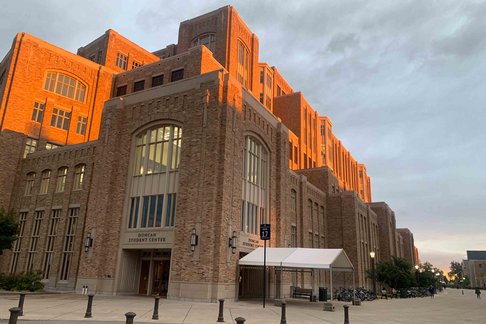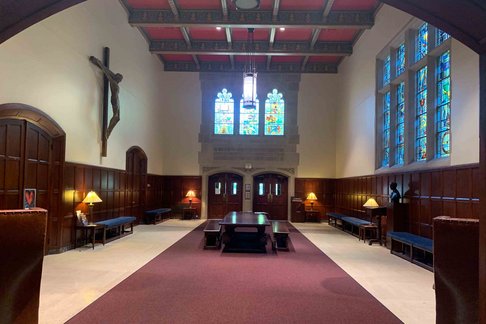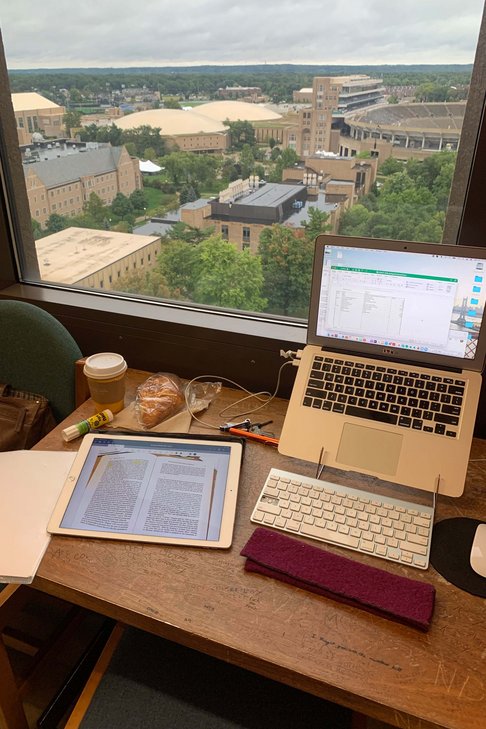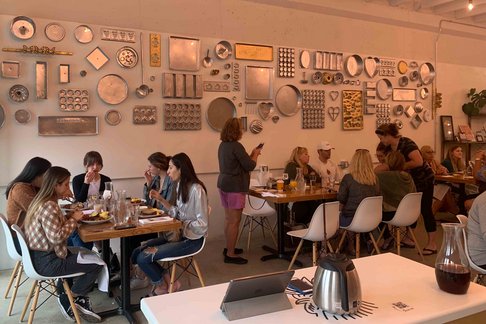Aloisia Moser an der Universität Notre Dame, Indiana (US).

I set out to visit the History of Philosophy Forum at the University of Notre Dame, just before the beginning of the semester in Linz to work on the Plato Chapter of my Habilitation. The chapter is about eikasia, which is imagination or conjecture, on the lowest rung of the divided line that Plato describes in the Republic, if one draws the line such that it is from bottom to top. Generally, my reading of the divided line tries to go against this grain, and I read eikasia as a crucial element of the act of thinking, that I claim is depicted in the line, and not so much a hierarchy of forms of thinking.
The first member of the History of Philosophy Forum I met at Notre Dame was Sean Kelsey, Professor of Philosophy who specializes in Ancient Greek philosophy, especially Plato and Aristotle. I had written to him beforehand and asked to discuss with him - among other things - a paper he had written in which he claimed that „roughly, that ‘perceiving’ or ‘judging’ is, not a rare and valuable achievement, laying hold of a piece of reality, but rather the mere ‘projecting’ of a piece of ourselves.” We discussed this in relation to the statement in Plato’s Republic’s the analogy of the Cave that the prisoners, “they are like us.” The way I read eikasia Kelsey told me was more akin to Aristotle than to Plato, and the same was attested to me later by Michael Weinman, my host at the Author meets Critic talk I gave at the Indiana University in Bloomington at the end of my trip.
Prof. Kelsey had already in our e-mail correspondence referred me to Prof. Dave O’Connor who he thought was more specialized with the notions of mimesis and methexis, that I aimed to discuss and learn more about to see whether I could read and utilize them in the way that I planned to in my book chapter. Prof. O Connor was kind enough to read my paper on mimesis and methexis (published in Monika Leisch-Kiesl: ZeichenSetzen, and which I translated for this occasion into English) and gave valuable comments.
https://historyofphilosophy.nd.edu/distinguished-visitors/aloisia-moser/

The University of Notre Dame is in South Bend, Indiana, which is located about 150 km south of Chicago. Unfortunately, the train between Chicago and South Bend takes 3 hours (compare this with Linz being located about 180 km West of Vienna and the train takes less than an hour and a half and runs every hour). The campus of Notre Dame is also North of downtown South Bend. I ended up renting a room in a house west of campus near the St. Joseph River, from which I could bike to campus in about 20 minutes. This turned out to be quite adventurous and it was good luck I brought my rain jacket and pants. On campus I was given a study carrell in the library, a tiny little room with no windows, but I soon moved my stuff to a table in the library by the window, since the philosophy library was on the 13th floor of the building, and thus I had a nice view. The building of Hesburgh Library is a landmark building with a huge Mosaic that depicts what the locals call “Touch Down Jesus” – Jesus holding up his hands just like the football players do in their game. The name came about since one can see Jesus from the football stadium which is in eye of sight not far from the library building. Football is a big deal in Indiana, probably much more so than soccer is in Austria.

My talk in the Fall Forum of the History of Philosophy Forum took place at the end of my second week in South Bend, on Friday at lunchtime. Several students and professors got together and listened to the work that I had done in connecting my ideas about how guessing is a crucial part of every act of thinking and how that could already be traced back to Plato. After the talk we all had a lunch outside in the shade of a building, the second week of my visit was sunny and felt like summer. There were other philosophy faculty members in the audience who joined for the lunch, and the discussion changed to how to make philosophy more fun and finally how our two departments were now connected through Erasmus and that we could send students from Linz to Notre Dame and from Notre Dame to Linz etc. Prof. O’Connor showed interest in teaching Plato in our summer school.

Finally, since my talk took place on a first Friday of the month, I was lucky to join the monthly South Bend walking tour later that afternoon. For 2.5 hours we walked a couple of blocks downtown. The tour guide was quite a storyteller and he made us touch the different buildings made from limestone and brick. He pointed out that it got so cold in the winter, that only the native materials could withstand the differences of heat and cold that ranged from record measures of 40 Degree Celsius in the summer and -30 in the winter. After a rainy weekend, which Prof. Katharina Kraus and I nevertheless used for a bike ride along the St. Joseph River. Before we had brunch at a local restaurant where we happened to find Plato’s forms.

We discussed our respective takes on Kant’s transcendental deduction, which I have suggested to read in a performative way while she has crafted an expressive reading of it. We finally said good-bye on the bank of the St. Joseph River.
Auf deutsch ist dieser Erfahrungsbericht hier zu finden.
